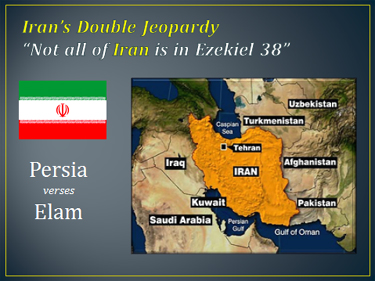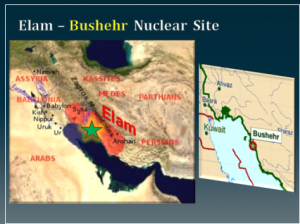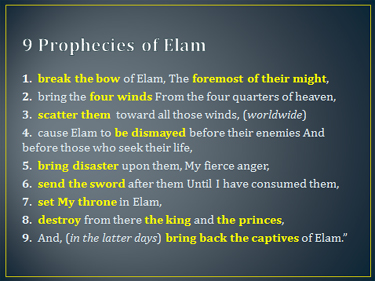The Dual Prophecies of Iran – Part Two
on Tuesday, February 21, 2012 by Bill Salus Welcome to part two of this study regarding Iran in Bible prophecy. Part one, called “Why Iran’s Absent from Psalm 83,” lodged logical explanations as to why Iran is not part of the Psalm 83 Arab – Israeli war. Part two provides logistical reasons by demonstrating that Iran seemingly faces a double jeopardy in the days to come. This entire study is taken from the commentary of Revelation Road, Hope Beyond the Horizon.
Welcome to part two of this study regarding Iran in Bible prophecy. Part one, called “Why Iran’s Absent from Psalm 83,” lodged logical explanations as to why Iran is not part of the Psalm 83 Arab – Israeli war. Part two provides logistical reasons by demonstrating that Iran seemingly faces a double jeopardy in the days to come. This entire study is taken from the commentary of Revelation Road, Hope Beyond the Horizon.
Even though Iran appears to be absent from the climactic, concluding Arab-Israeli War, they are not excluded from two other significant end-time’s events. The one most widely taught among eschatologists today is described in Ezekiel 38, and is commonly called the Gog of Magog invasion of Israel. In Ezekiel’s prophecy modern day Iran is represented by ancient Persia, and is clearly identified militarily “with a shield and a helmet,” in Russia’s coalition.
Persia, Ethiopia, and Libya are with them, all of them with shield and helmet; (Ezekiel 38:5)
Presently Iran is ranked #12 among world armies, and if Ezekiel’s prophecy were to find fulfillment today, this would position Iran as the third strongest army within the Magog coalition behind Russia ranked #2, and Turkey ranked #6. Moreover, if Iran was included in Psalm 83:6-8, which does not appear to be the case, it would make it the strongest army within the confederacy in front of Egypt (#16), Saudi Arabia (#26), and Syria (#35).
Interestingly, Iran presently possesses strong proxy relationships, and bonafide war-pacts, with Syria, Hezbollah, and Hamas. All three of these proxies appear to be part of the Psalm 83 Arab confederacy. And yet, Iran somehow gets excluded or, otherwise excused from participating directly in Psalm 83.
Some scholars, like Dr. Mark Hitchcock and Dr. Thomas Ice, teach that Psalm 83 is an imprecatory prayer and probably not a specific prophecy. If their interpretations are correct, then the preponderance of this study becomes a useless exercise in futility, and the current Mideast crisis has little to no connection with Psalm 83 whatsoever. However, if they are wrong, and I believe my books Isralestine and Revelation Road evidences that they are; then one must wonder why Iran’s military might is not incorporated in the Psalm war.
Case in point, Psalm 83:4 says;
They have said, “Come, and let us cut them off from being a nation, That the name of Israel may be remembered no more.”
Comparatively, Iran’s president Mahmoud Ahmadinejad has declared publicly on several occasions that, “Israel must be wiped off the map.”
These similar quotes suggest that Iran and the confederacy of Psalm 83 share the same Anti-Semitic sentiment toward the nation of Israel. If so; then why does Iran appear to be absent from Psalm 83?
Perhaps Persia’s utter destruction in Ezekiel 38:16 – 39:6 prohibits Iran from fighting in Psalm 83. Although this would satisfactorily answer the question about Iran’s apparent absence in the Arab war, the problem is that Psalm 83 probably precedes Ezekiel 38. If this is the case, then Iran’s “shield and helmet,” could still exist when the Arabs come against Israel. If so; then why don’t the Arabs invite mighty Iran to participate in their war party?
The prophecy that may precede Ezekiel 38 – 39, and answer the question about Iran’s conspicuous absence in Psalm 83 is located in Jeremiah 49:34-39. Jeremiah 49:35 predicts Elam (Iran) gets struck at the “foremost of its might,” which if unfulfilled as of yet, could allude to its nuclear program. The next verse says the Elamites (Iranians) will be scattered out of the immediate area into world nations.
Thus says the LORD of hosts: “Behold, I will break the bow of, The foremost of their might. Against Elam I will bring the four winds From the four quarters of heaven, And scatter them toward all those winds; There shall be no nations where the outcasts of Elam will not go. (Jeremiah 49:35-36, nkjv)
Jeremiah and Ezekiel were contemporaries of each other. They both wrote over 2500 years ago. Why did Ezekiel prophesy about Persia, and Jeremiah about Elam? The probable answers are three-fold;
1. Geographically – Elam and Persia occupied two adjoining territories at the time,
2. Culturally – these territories consisted of differing ethnicities, and distinct civilizations,
3. Prophetically – the two prophets were probably predicting separate events.
 Presently, Persia and Elam comprise greater Iran. Elam covered west-central Iran as depicted in the image, and Persia encompassed most of the other surrounding territory. A careful study suggests both Ezekiel’s and Jeremiah’s Iranian prophecies appear to be unfulfilled end time events. If so, this suggests that modern day Iran faces a double jeopardy in the last days.
Presently, Persia and Elam comprise greater Iran. Elam covered west-central Iran as depicted in the image, and Persia encompassed most of the other surrounding territory. A careful study suggests both Ezekiel’s and Jeremiah’s Iranian prophecies appear to be unfulfilled end time events. If so, this suggests that modern day Iran faces a double jeopardy in the last days.
Jeremiah predicts that Elam will be struck at the foremost place of its strength. If such an attack occurred in the near future that would probably be its nuclear site(s). Not necessarily all sites, but specifically sites existing within the boundaries of ancient Elam. A prime target would be the Bushehr nuclear site identified in the image.
Subsequently, the prophet warns that after the attack the affected populations are forced to scatter from the area. Jeremiah says, “There shall be no nations where the outcasts of Elam will not go.” This could be the result of Iranian’s attempting to flee from an isolated nuclear disaster. Should the Bushehr nuclear reactor be struck, this becomes a very real possibility because the facility is loaded with Russian supplied fuel rods. These rods were loaded during the summer of 2010. At the time former UN Ambassador John Bolton warned that once the rods were loaded in place, an attack upon the site could result in severe radioactive fallout.
If Jeremiah 49:34-39 is alluding to a pre-Psalm 83 strike upon Iran’s nuclear program, this could partially explain why the rogue state is not a participant in the Psalm. Additionally, perhaps nuclear fallout causes only the Iranians from the central west coast to evacuate into other nations, which would still leave the preponderance of Persia, (northern Iran) with some remaining shields and helmets to fight with in Ezekiel 38.
It is important to note that Ezekiel seems to intentionally omit Elam from the Gog of Magog invasion. This strongly suggests that not all of modern-day Iran participates in the infamous Gog of Magog invasion of Israel. This conclusion can be safely drawn by recognizing that Ezekiel 32:24-26 identifies Elam and Meshech and Tubal. Meshech and Tubal are listed in the Magog invasion, but Elam is not. Why not? Why didn’t Ezekiel list Elam alongside Persia to identify the entirety of modern-day Iran in his predicted invasion?
The fact that Ezekiel lists Persia in Ezekiel 27:10 and Ezekiel 38:5, and Elam in Ezekiel 32:24 implies that he recognized the territorial and ethnic distinctions between these two populations during his time. He probably omits Elam for the same reason that he omits the Arab populations identified in Psalm 83:6-8, which is because Elam and the Arabs of Psalm 83 do not participate in the Ezekiel 38 invasion.
The probable reason the Psalm 83 Arabs abstain is because they are dealt with in a prior separate war, won by the IDF. The likely reason Elam isn’t listed is because Jeremiah 49:34-39 tells us the Elamites are also involved in their own separate prophecy. Thus, there appear to be three prophecies identified: Psalm 83 (Arabs), Ezekiel 38-39 (Persians), and Jeremiah 49:34-39 (Elamites).
 In summary, it is important to note that clear territorial distinctions existed between Elam and Persia when Jeremiah and Ezekiel prophesied. It is doubtful that all of modern-day Iran participates in the Magog invasion of Israel in Ezekiel 38. More likely is the possibility that only northern Iran joins in with Magog (Russia); otherwise Ezekiel should have included both Persia and Elam in his prophecy. Since Elam is not part of Ezekiel 38, it suggests that Jeremiah’s prophecy regarding Elam is a separate prophetic event. If Elam is struck at the foremost of its might prior to the fulfillment of Ezekiel 38, then this could be the reason Ezekiel omitted Elam from his prophecy.
In summary, it is important to note that clear territorial distinctions existed between Elam and Persia when Jeremiah and Ezekiel prophesied. It is doubtful that all of modern-day Iran participates in the Magog invasion of Israel in Ezekiel 38. More likely is the possibility that only northern Iran joins in with Magog (Russia); otherwise Ezekiel should have included both Persia and Elam in his prophecy. Since Elam is not part of Ezekiel 38, it suggests that Jeremiah’s prophecy regarding Elam is a separate prophetic event. If Elam is struck at the foremost of its might prior to the fulfillment of Ezekiel 38, then this could be the reason Ezekiel omitted Elam from his prophecy.
Moreover, Jeremiah 49:34-39 introduces nine related prophecies concerning Elam. This study has only discussed two of them. These nine prophecies are identified in the image, and are thoroughly explained in the commentary portion of Revelation Road. The pertinent commentary also presents a brief history lesson concerning Elam, and explains why Jeremiah’s Elamite prophecies still remain unfulfilled.
In the final analysis, Jeremiah’s nine prophecies of Elam may be simply adding more details to Ezekiel’s Gog of Magog invasion; but I doubt it.
To learn more about what the Bible says about the future of Iran, order your copy of Revelation Road here.
……………………………………….
World army rankings were gathered over the Internet on 2/21/12 at this link: http://www.globalfirepower.com/


